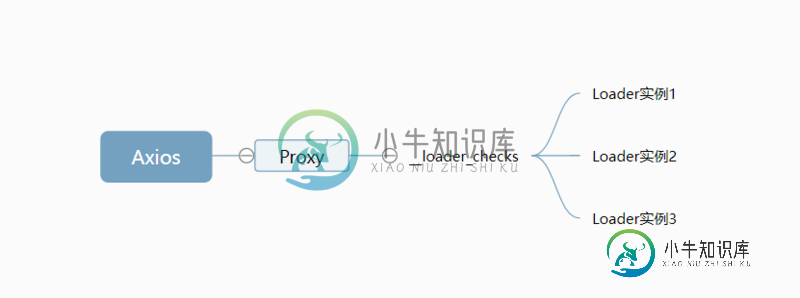一起写一个即插即用的Vue Loading插件实现
无论最终要实现怎样的网站,Loading状态都是必不可少的一环,给用户一个过渡喘息的机会也给服务器一个递达响应的时间。
从使用方式说起
不管从0开始写起还是直接下载的Loading插件,都会抽象为一个组件,在用到的时候进行加载Loading,或者通过API手动进行show或者hide
<wait>
</wait>
...
this.$wait.show()
await fetch('http://example.org')
this.$wait.hide()
或者通过Loading状态进行组件间的切换
<loader v-if="isLoading"> </loader> <Main v-else> </Main>
。要想注册成全局状态,还需要给axios类的网络请求包添加拦截器,然后设置一个全局Loading状态,每次有网络请求或者根据已经设置好的URL将Loading状态设置为加载,请求完成后在设置为完成。
注册axios拦截器:
let loadingUrls = [
`${apiUrl}/loading/`,
`${apiUrl}/index/`,
`${apiUrl}/comments/`,
...
]
axios.interceptors.request.use((config) => {
let url = config.url
if (loadingUrls.indexOf('url') !== -1) {
store.loading.isLoading = true
}
})
axios.interceptors.response.use((response) => {
let url = response.config.url
if (loadingUrls.indexOf('url') !== -1) {
store.loading.isLoading = false
}
})
使用时在每个组件下获取出loading状态,然后判断什么时候显示loading,什么时候显示真正的组件。
<template>
<div>
<loader v-if="isLoading">
</loader>
<Main v-else>
</Main>
</div>
</template>
<script>
...
components: {
loader
},
computed: {
isLoading: this.$store.loading.isLoading
},
async getMainContent () {
// 实际情况下State仅能通过mutations改变.
this.$sotre.loading.isLoading = false
await axios.get('...')
this.$sotre.loading.isLoading = false
},
async getMain () {
await getMainContent()
}
...
</script>
在当前页面下只有一个需要Loading的状态时使用良好,但如果在同一个页面下有多个不同的组件都需要Loading,你还需要根据不同组件进行标记,好让已经加载完的组件不重复进入Loading状态...随着业务不断增加,重复进行的Loading判断足以让人烦躁不已...
整理思路
Loading的核心很简单,就是请求服务器时需要显示Loading,请求完了再还原回来,这个思路实现起来并不费力,只不过使用方式上逃不开上面的显式调用的方式。顺着思路来看,能进行Loading设置的地方有,
- 设置全局拦截,请求开始前设置状态为加载。
- 设置全局拦截,请求结束后设置状态为完成。
- 在触发请求的函数中进行拦截,触发前设置为加载,触发后设置为完成。
- 判断请求后的数据是否为非空,如果非空则设置为完成
最终可以实现的情况上,进行全局拦截设置,然后局部的判断是最容易想到也是最容易实现的方案。给每个触发的函数设置before和after看起来美好,但实现起来简直是灾难,我们并没有before和after这两个函数钩子来告诉我们函数什么时候调用了和调用完了,自己实现吧坑很多,不实现吧又没得用只能去原函数里一个个写上。只判断数据局限性很大,只有一次机会。
既然是即插即用的插件,使用起来就得突出一个简单易用,基本思路上也是使用全局拦截,但局部判断方面与常规略有不同,使用数据绑定(当然也可以再次全局响应拦截),咱们实现起来吧~。
样式
Loading嘛,必须得有一个转圈圈才能叫Loading,样式并不是这个插件的最主要的,这里直接用CSS实现一个容易实现又不显得很糙的:
<template>
<div class="loading">
</div>
</template>
...
<style scoped>
.loading {
width: 50px;
height: 50px;
border: 4px solid rgba(0,0,0,0.1);
border-radius: 50%;
border-left-color: red;
animation: loading 1s infinite linear;
}
@keyframes loading {
0% { transform: rotate(0deg) }
100% { transform: rotate(360deg) }
}
</style>
固定大小50px的正方形,使用border-radius把它盘得圆润一些,border设置个进度条底座,border-left-color设置为进度条好了。
演示地址

绑定数据与URL
提供外部使用接口
上面思路中提到,这个插件是用全局拦截与数据绑定制作的:
- 暴露一个 source 属性,从使用的组件中获取出要绑定的数据。
- 暴露一个 urls 属性,从使用的组件中获取出要拦截的URL。
<template>
...
</template>
<script>
export default {
props: {
source: {
require: true
},
urls: {
type: Array,
default: () => { new Array() }
}
},
data () {
return { isLoading: true }
},
watch: {
source: function () {
if (this.source) {
this.isLoading = false
}
}
}
}
</script>
<style scoped>
....
</style>
不用关心source是什么类型的数据,我们只需要监控它,每次变化时都将Loading状态设置为完成即可,urls我们稍后再来完善它。
设置请求拦截器
拦截器中需要的操作是将请求时的每个URL压入一个容器内,请求完再把它删掉。
Vue.prototype.__loader_checks = []
Vue.prototype.$__loadingHTTP = new Proxy({}, {
set: function (target, key, value, receiver) {
let oldValue = target[key]
if (!oldValue) {
Vue.prototype.__loader_checks.forEach((func) => {
func(key, value)
})
}
return Reflect.set(target, key, value, receiver)
}
})
axios.interceptors.request.use(config => {
Vue.prototype.$__loadingHTTP[config.url] = config
return config
})
axios.interceptors.response.use(response => {
delete Vue.prototype.$__loadingHTTP[response.config.url]
return response
})
将其挂载在Vue实例上,方便我们之后进行调用,当然还可以用Vuex,但此次插件要突出一个依赖少,所以Vuex还是不用啦。
直接挂载在Vue上的数据不能通过computed或者watch来监控数据变化,咱们用Proxy代理拦截set方法,每当有请求URL压入时就做点什么事。Vue.prototype.__loader_checks用来存放哪些实例化出来的组件订阅了请求URL时做加载的事件,这样每次有URL压入时,通过Proxy来分发给订阅过得实例化Loading组件。

订阅URL事件
<template>
...
</template>
<script>
export default {
props: {
source: {
require: true
},
urls: {
type: Array,
default: () => { new Array() }
}
},
data () {
return { isLoading: true }
},
watch: {
source: function () {
if (this.source) {
this.isLoading = false
}
}
},
mounted: function () {
if (this.urls) {
this.__loader_checks.push((url, config) => {
if (this.urls.indexOf(url) !== -1) {
this.isLoading = true
}
})
}
}
}
</script>
<style scoped>
....
</style>
每一个都是一个崭新的实例,所以直接在mounted里订阅URL事件即可,只要有传入urls,就对__loader_checks里每一个订阅的对象进行发布,Loader实例接受到发布后会判断这个URL是否与自己注册的对应,对应的话会将自己的状态设置回加载,URL请求后势必会引起数据的更新,这时我们上面监控的source就会起作用将加载状态设置回完成。

使用槽来适配原来的组件
写完上面这些你可能有些疑问,怎么将Loading时不应该显示的部分隐藏呢?答案是使用槽来适配,
<template>
<div>
<div class="loading" v-if="isLoading" :key="'loading'">
</div>
<slot v-else>
</slot>
</div>
</template>
<script>
export default {
props: {
source: {
require: true
},
urls: {
type: Array,
default: () => { new Array() }
}
},
data () {
return { isLoading: true }
},
watch: {
source: function () {
if (this.source) {
this.isLoading = false
}
}
},
mounted: function () {
if (this.urls) {
this.__loader_checks.push((url, config) => {
if (this.urls.indexOf(url) !== -1) {
this.isLoading = true
}
})
}
}
}
</script>
<style scoped>
....
</style>
还是通过isLoading判断,如果处于加载那显示转圈圈,否则显示的是父组件里传入的槽,
这里写的要注意,Vue这里有一个奇怪的BUG,
<div class="loading" v-if="isLoading" :key="'loading'"> </div> <slot v-else> </slot>
在有<slot>时,如果同级的标签同时出现v-if与CSS选择器且样式是scoped,那用CSS选择器设置的样式将会丢失,<div v-if="isLoading" :key="'loading'">如果没有设置key那.loading的样式会丢失,除了设置key还可以把它变成嵌套的<div v-if="isLoading"> <div></div> </div>。
注册成插件
Vue中的插件有四种注册方式,这里用mixin来混入到每个实例中,方便使用,同时我们也把上面的axios拦截器也注册在这里。
import axios
import Loader from './loader.vue'
export default {
install (Vue, options) {
Vue.prototype.__loader_checks = []
Vue.prototype.$__loadingHTTP = new Proxy({}, {
set: function (target, key, value, receiver) {
let oldValue = target[key]
if (!oldValue) {
Vue.prototype.__loader_checks.forEach((func) => {
func(key, value)
})
}
return Reflect.set(target, key, value, receiver)
}
})
axios.interceptors.request.use(config => {
Vue.prototype.$__loadingHTTP[config.url] = config
return config
})
axios.interceptors.response.use(response => {
delete Vue.prototype.$__loadingHTTP[response.config.url]
return response
})
Vue.mixin({
beforeCreate () {
Vue.component('v-loader', Loader)
}
})
}
}
使用
在入口文件中使用插件
import Loader from './plugins/loader/index.js' ... Vue.use(Loader) ...
任意组件中无需导入即可使用
<v-loader :source="msg" :urls="['/']">
<div @click="getRoot">{{ msg }}</div>
</v-loader>
根据绑定的数据和绑定的URL自动进行Loading的显示与隐藏,无需手动设置isLoading是不是该隐藏,也不用调用show与hide在请求的方法里打补丁。
测试地址
其他
上面的通过绑定数据来判断是否已经响应,如果请求后的数据不会更新,那你也可以直接在axios的response里做拦截进行订阅发布模式的响应。
最后
咳咳,又到了严(hou)肃(yan)认(wu)真(chi)求Star环节了,附上完整的项目地址(我不会告诉你上面的测试地址里的代码也很完整的,绝不会!)。
以上就是本文的全部内容,希望对大家的学习有所帮助,也希望大家多多支持小牛知识库。
-
构思插件的功能 import BScroll from '@better-scroll/core' import MyPlugin from '@better-scroll/my-plugin' BScroll.use(MyPlugin) const bs = new BScroll('.wrapper', { myPlugin: { scrollText:
-
前面已经提过在运行 logstash 的时候,可以通过 --pluginpath 参数来加载自己写的插件。那么,插件又该怎么写呢? 插件格式 一个标准的 logstash 输入插件格式如下: require 'logstash/namespace' require 'logstash/inputs/base' class LogStash::Inputs::MyPlugin < LogStash:
-
0.7 新版功能. Flask 0.7 引入了即插视图,灵感来自 Django 的基于类而不是函数的通用视图。 其主要目的是让你可以对已实现的部分进行替换,并且这个方式可以定制即插视 图。 基本原则 想象你有一个从数据库载入一个对象列表并渲染到视图的函数: @app.route('/users/') def show_users(page): users = User.query.all(
-
1.4. 开始写第一个插件 代码位于plugin_first 让我们动手改造一下tab.js吧: 1.4.1. 代码 ;(function($) { $.fn.tab = function(options) { // 将defaults 和 options 参数合并到{} var opts = $.extend({},$.fn.tab.defaults,
-
现在你已经熟悉了 Babel 的所有基础知识了,让我们把这些知识和插件的 API融合在一起来编写第一个 Babel 插件吧。 先从一个接收了当前babel对象作为参数的 function 开始。 export default function(babel) { // plugin contents } 由于你将会经常这样使用,所以直接取出 babel.types 会更方便:(译注:这是 ES2
-
之前写过用BLOG套件写博客的,但BlogTNG在很多方面更有优势。经过较长时间的沉寂后,BlogTNG的开发再度开始,现在已经可以使用并且在很多方面超过了原有的BLOG套件。 先大概介绍下BlogTNG: 使用SQLite存储元数据,比如标签、评论等。文章本身仍然以Dokuwiki的文本文件形式存储 基本使用更为统一、简单 灵活性 Feed更合理,不会在文章内容修改后重复生成Feed 没有评论过

